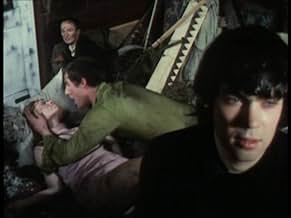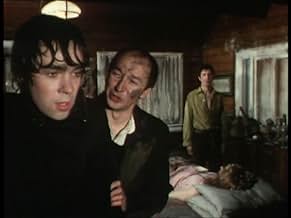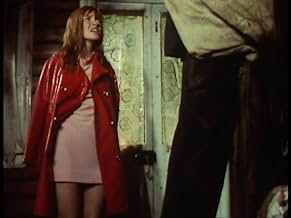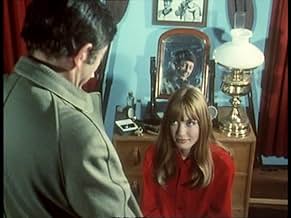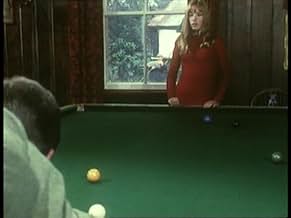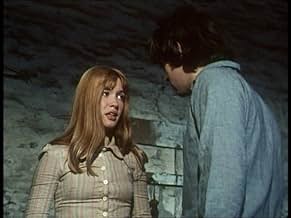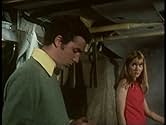Ajouter une intrigue dans votre langueThree teenagers discover a mysterious set of owl and flower-patterned dinner plates in the attic and the magical ancient legend of the "Mabinogion" comes to life once again in their Welsh va... Tout lireThree teenagers discover a mysterious set of owl and flower-patterned dinner plates in the attic and the magical ancient legend of the "Mabinogion" comes to life once again in their Welsh valley.Three teenagers discover a mysterious set of owl and flower-patterned dinner plates in the attic and the magical ancient legend of the "Mabinogion" comes to life once again in their Welsh valley.
Parcourir les épisodes
Avis à la une
10gawayne7
This is one of the best TV shows ever produced, in the same vein as the "Prisoner". It has an edge that is missing from drama nowadays. The 60's and 70's were a unique time for culture- film, drama and music and this is no exception. Imaginative and eerie at the same time, with solid performances from all the cast- it is well worth buying the DVD. which includes a booklet that gives some insights into the making of the series and the Welsh legend which was the inspiration. A classic and a rare masterpiece of TV.
This is not actually a movie but a TV series adapted from an award winning novel. Although Garner's work was marketed as children's fiction at his best he is multi-layered and this is one of his best. Alison is on holiday with her newly re-married mother, stepfather and stepbrother at a house in a remote Welsh valley. She begins a relationship with Gwyn, the son of the housekeeper, much to the disgust of her mother but soon parental disapproval is the least of their worries when Gwyn finds an owl-patterned dinner service - the Owl Service of the title - hidden away in the loft and releases an ancient magic into the valley. The past is re-enacted in the present, the tragedy of what has happened over and over in the valley is relived with a modern slant. A brief description like this can't do justice to the creeping tension of the story where even the tiniest, seemingly innocuous, event resonates with unfolding significance. I have the series on video,taped on its last TV outing in 1985 so now twenty years old, and it's not going to last for ever.
Since I wrote this post originally in 2005, and after some lobbying of Granada and Network DVD, the series has now been released. If you've never seen it before buy it, you won't be disappointed. If you have seen it before no doubt you will have already bought it as I have.
Since I wrote this post originally in 2005, and after some lobbying of Granada and Network DVD, the series has now been released. If you've never seen it before buy it, you won't be disappointed. If you have seen it before no doubt you will have already bought it as I have.
This is simply one of the finest children's TV series ever made! Yes, I really do mean that. It harks back to a age of nostalgia and lost times. So many wonderful memories of me as a very young child watching this. The vintage age of children's TV was the late 60s too around 1980.oh,and to the reviewers who only gave this one star and complaining about the actors ages and production, it was 1969!and you obviously don't have a clue what you are watching. Some people just like to belittle for the sake of it.
An 8-part TV series that includes a supernatural theme based on folklore, murder, (hinted, off-screen) sex, and demonic possession.
So perfect Sunday teatime viewing for all the family in 1970, with the first episodes being shown just before Christmas 1969.
No need to go into the story too much. It is retelling/updating/"inspired by" story based on a tale from the Mabinogion by acclaimed children's author Alan Garner, who was heavily involved in this TV version of his novel (and as a result it is a very faithful version). It features three young people (probably meant to be aged around 15-16) in an emotional triangle (to call it a love triangle would be misleading), living in a Welsh manor house in a valley cut off from the outside world (no electricity, phone, etc. - which was entirely plausible for the late 60s/early 70s).
The discovery of a strange dinner service results takes over the young girl - Alison - (played very well by an actress some 10 years older than the part she is playing) who is compelled to trace the pattern on the plates and make paper owls. And so the story begins.
After this it gets quite complex - to the extent that the summary of the previous episode that starts episodes 2-8 is absolutely required viewing, even if you are binging the entire series (its available on YouTube) because you will have missed something!
The three young actors (though they are significantly older than the parts they play) do a great job holding together a tale that basically only has six parts in it (the others being the father of two of the children, a live-in housekeeper and mother of the third, and a strange and apparently a little mad handyman/gardener.
Spread over 8 25-minute episodes the story will seem a little slow to modern viewers, with not a great deal of action (you can literally count the number of spots of blood that are shown), but what is hinted at and what probably happens off camera is another matter entirely.
Perhaps this is where the family viewing comes in because adult viewers will likely get the hints that children will miss, such as - to take one fairly mild example - why is Alison "ill" and in bed at the start, in her red nightdress, despite actually appearing quite perky? Not that hard for an adult to guess.
Each episode pushes the story forward with the last one being quite strong stuff, with what is essentially a form of demonic possession centre screen. A suspect a few viewers choked on the Sunday tea when this was shown.
But it is not just the story that would raise eyebrows - and actually make this unfilmable today (for children anyway) - it is also the style of filming. There may be little blood, but the camera loves Alison's legs in their 1960s short skirts to an extent that would be very worrying if you did not know that the actress was 25.
Overall this is a dark, complex, difficult but brilliant drama that uses folklore and the supernatural in a way that would be utterly impossible for the target audience today.
So perfect Sunday teatime viewing for all the family in 1970, with the first episodes being shown just before Christmas 1969.
No need to go into the story too much. It is retelling/updating/"inspired by" story based on a tale from the Mabinogion by acclaimed children's author Alan Garner, who was heavily involved in this TV version of his novel (and as a result it is a very faithful version). It features three young people (probably meant to be aged around 15-16) in an emotional triangle (to call it a love triangle would be misleading), living in a Welsh manor house in a valley cut off from the outside world (no electricity, phone, etc. - which was entirely plausible for the late 60s/early 70s).
The discovery of a strange dinner service results takes over the young girl - Alison - (played very well by an actress some 10 years older than the part she is playing) who is compelled to trace the pattern on the plates and make paper owls. And so the story begins.
After this it gets quite complex - to the extent that the summary of the previous episode that starts episodes 2-8 is absolutely required viewing, even if you are binging the entire series (its available on YouTube) because you will have missed something!
The three young actors (though they are significantly older than the parts they play) do a great job holding together a tale that basically only has six parts in it (the others being the father of two of the children, a live-in housekeeper and mother of the third, and a strange and apparently a little mad handyman/gardener.
Spread over 8 25-minute episodes the story will seem a little slow to modern viewers, with not a great deal of action (you can literally count the number of spots of blood that are shown), but what is hinted at and what probably happens off camera is another matter entirely.
Perhaps this is where the family viewing comes in because adult viewers will likely get the hints that children will miss, such as - to take one fairly mild example - why is Alison "ill" and in bed at the start, in her red nightdress, despite actually appearing quite perky? Not that hard for an adult to guess.
Each episode pushes the story forward with the last one being quite strong stuff, with what is essentially a form of demonic possession centre screen. A suspect a few viewers choked on the Sunday tea when this was shown.
But it is not just the story that would raise eyebrows - and actually make this unfilmable today (for children anyway) - it is also the style of filming. There may be little blood, but the camera loves Alison's legs in their 1960s short skirts to an extent that would be very worrying if you did not know that the actress was 25.
Overall this is a dark, complex, difficult but brilliant drama that uses folklore and the supernatural in a way that would be utterly impossible for the target audience today.
Strange that reviewers' opinion about this series is split, in that there is very little of merit in here at all, beyond Edwin Richfield's trademark twitchiness. It is extremely slow, stretched to breaking point across four hours. The three juvenile leads are extraordinarily inept and equally thumpable (well, maybe Roger is marginally worse than the others). Eerie moments are not followed up, so their effects dissipate. Mysteries are raised and never resolved. Bafflingly, the character Margaret, who is fairly crucial, is never shown; even the DVD notes fail to explain why. Some scenes have to go to enormous lengths to work around her absence; even a cardboard cut-out in silhouette would have been preferable. It is not stylish; the camera is generally static and the editing plodding. And the resolution, when it comes, resolves very little, choosing instead to wrap it all up in sci-fi gobbledegook.
And yet somehow it has become a cult classic. Go figure.
And yet somehow it has become a cult classic. Go figure.
Le saviez-vous
- AnecdotesAs the first fully scripted colour production by Granada Television, the series takes full advantage of the color red, not only in the form of Gillian Hills's stunning red hair, but her wardrobe is almost entirely made up of red miniskirts, bikinis, hats and raincoats.
- ConnexionsFeatured in The Worlds of Fantasy: The Child Within (2008)
- Bandes originalesTon Alarch
Performed by Jean Bell
[closing music for each episode]
Meilleurs choix
Connectez-vous pour évaluer et suivre la liste de favoris afin de recevoir des recommandations personnalisées
- How many seasons does The Owl Service have?Alimenté par Alexa
Détails
Contribuer à cette page
Suggérer une modification ou ajouter du contenu manquant

